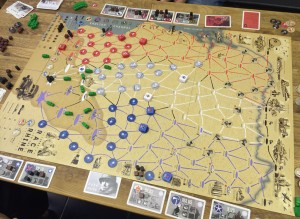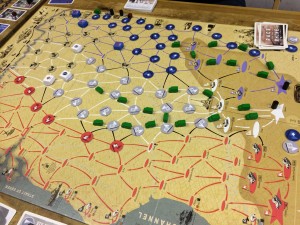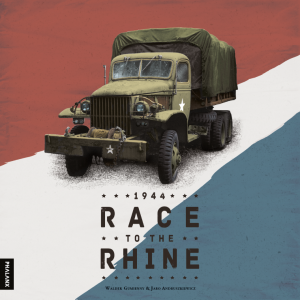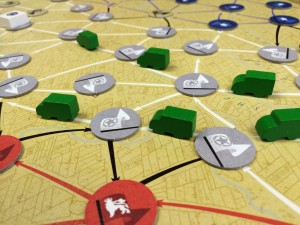Review: Race to the Rhine
Posted by James (admin) on August 1st, 2014
 Race to the Rhine is a game for up to 3 players who each play a WWII Allied General. You may be on the same side of the war but this is not a co-operative game – first player over the Rhine, or the player with the most medals if time runs out, wins. As you’re on the same side, there’s no combat against each other but you are in competition for the central supplies and you can place enemy forces to hinder your opponents.
Race to the Rhine is a game for up to 3 players who each play a WWII Allied General. You may be on the same side of the war but this is not a co-operative game – first player over the Rhine, or the player with the most medals if time runs out, wins. As you’re on the same side, there’s no combat against each other but you are in competition for the central supplies and you can place enemy forces to hinder your opponents.
THE GAME
Race to the Rhine is about planning and logistics as you need to keep your Corps supplied with Ammo, Fuel and Food which requires careful timing of your actions. Players take turns performing two actions: Move Corps, Gain Supplies, Gain Trucks, Place Trucks (moves supplies), Recon, and Airborne Units.
Movement & Combat
Each player moves their units (Corps) towards the Rhine via a network of roads; however, each player stays within their coloured section which occasionally overlap. A Move action moves one Corps up to 3 locations (costing 1 fuel) drawing a card when entering each empty location to see what happens. You normally draw from your own deck (mostly beneficial with a few negative cards). If the location contains an Axis marker, you draw from the Axis deck (tough enemy). If you successfully enter a location, you place one of your control markers there. Combat against Axis forces requires spending various amounts of ammo and sometimes fuel; otherwise, you lose the combat, spend what you can, but don’t enter the location.
Supplies
To keep moving, Corps need fuel, and usually ammo and food too. Players have a main supply depot location, plus may take control of locations with small supply depots. ‘Take Supplies’ allows you to take either 3 of the same kind from the central pool (if any remain), or one of each type. Supplies are placed in your main depot (or, if you took one of each, directly to a small depot).
‘Place Trucks’ allows several trucks to be placed on empty roads. Placing a truck on an empty road between two of your controlled locations allows you to move up to 5 supplies from one location to the other. However, your roads can quickly fill to cause a traffic jam blocking your supplies getting to where they’re needed.
It’s only when one of the players takes the last truck from the general pool that all the trucks on the board are removed (which opens up the roads again). At the same time, the general pool of supplies and trucks in refilled, player’s truck abilities increase, and each Corps must spend 1 food or be immobile until they do.
Victory & Game End
The game ends when immediately when one player crosses the Rhine or when time runs out. At the end of your turn, you must either: Add an Axis marker, or Counter-attack. Adding a marker creates an ever-growing network that spreads out from Dusseldorf – so players place them to inconvenience their opponents. Counter-attack allows a player to remove one of their opponent’s control markers if it’s exposed (i.e. too far from their Corps and base, and can be reached from Dusseldorf). This allows a player to disrupt an opponent’s over-extended supply line and can even make them return a medal from controlling that location. So, the Counter-attack option (no Axis marker placed) and defeating Axis markers (Axis marker returns to the pool) extend the game’s length.
If time runs out, the player with the most medals wins. Medals are earned by controlling specific locations, giving food to civilians (when those cards are drawn), and defeating Axis forces (some give a medal, and the rest can be combined for medals).
THOUGHTS
I really like the idea of Race to the Rhine as it’s a WWII game about logistics under pressure rather than combat. It’s certainly an interesting theme and the game mechanics feel original too.
With only 2 actions per turn, the game definitely feels like a race, especially as it’s a relatively short game too (as players have only 8 or 9 turns if the game length doesn’t get extended).
It’s soon obvious that there’s a lot to balance in a short time. Co-ordinating the different actions to gain and move supplies, whilst not grid-locking your trucks, to keep your Corps moving is essential. However, you also need to move your Corps in a way that minimises exposing locations to counter attack (easily done if you advance one Corps on its own). Therefore, you need to plan and adapt to unexpected circumstances that cards reveal. Also, it’s important to react to what other players are taking from the general supply pool because your opponents might take what you need.
The asymmetric styles of the Generals is a good thing as it means each requires a slightly different approach. Montgomery, Patton and Bradley each have their own start situation (position and supplies) and special ability, but the main difference comes from the areas of the board through which each must progress. Also, it’s nice how some history has been incorporated to create this asymmetry too.
Player interaction is fairly limited and indirect – the main interaction is the taking of supplies from the main pool before another player (plus the lesser items of placing of Axis markers, counter-attacks, and taking control of a location that is in 2 areas). The theme means it wouldn’t feel right if there was too much direct interaction, but it can mean it can feel slightly multi-player solo at times, so I would have liked just a little more.
The trucks and movement of supplies is a clever game mechanic and was one of the features I remember stood out when I read the designer diary. It forces some difficult decisions as the trucks and routes are in just as short supply as the supplies being moved. Also, do you move supplies immediately or wait until trucks are fully loaded? However, I was a bit disappointed that the small supply depots which the red and blue generals have access to (where supplies can be immediately placed) means those players are indirectly incentivised not to use the truck game mechanic to move supplies from their main depot. This also means competition over trucks is reduced for players who are using them. Maybe fewer small depots would avoid this or only 2 supplies should be placed in a small depot rather than 3.
In all my non-solo games, no-one has yet crossed the Rhine, although it’s been close. This may say more about my players but we’re all experienced gamers. It’s not a problem because no-one wants a game that’s not a challenge, but it’s good to be aware of it in your first game because earning medals is actually much more important than it first appears. (A player with more medals than their opponents can try preventing them crossing the Rhine by making the clock run down and/or hindering their progress by taking supplies they need.)
My main concern about the game is replayability. Each General is quite different, but each seems like a puzzle which has a ‘perfect’ solution, i.e. there is a most efficient number of actions that will cross the Rhine. For example, the blue General’s fastest route seems to be to advance their Corps in a straight line up the edge of the board (via the small depots) because it’s quickest way to advance over the Rhine (and their Corps can be spread along the advance to keep locations secure from counter-attacks too). Unless I’m missing something, there seems little reason to deviate from this tactic which means the cards drawn become the major factor as to whether you succeed or fail at executing the ‘perfect’ performance. This effect is less of a problem with multiple players because their actions force you to go ‘off-script’ and react (to some extent) to what they have done, or may do. I like games that offer multiple routes to victory but I’m not sure I can see enough potential for this within each General when replayed.
The game’s components are all of excellent quality – the green trucks are especially cool and the box is incredibly sturdy too.

A 2-player game using white and blue. All red locations are assumed to be controlled by the red player.
Solo Play
In Solo play, the goal is to cross the Rhine in as few turns as possible. I enjoyed my first solo games as I liked the logistical challenge of using actions efficiently to move units, supplies and Corps. The potential locations where Axis markers may appear are defined in the rules and dice are used to determine which get placed using some rules to ensure it’s more than purely random. Any exposed locations always get counter-attacked too.
However, as there are no other players with whom to fight with over the supplies, I found that solo play suffered the most from the ‘solution’ mentioned above so each General seemed to lack the need for a different approach when replayed. This meant that, whilst I felt each of the Generals played differently, each play of a General felt very similar. Once I’d figured out a General’s fastest route (if there were no cards/Axis markers), my performance was determined by which cards I drew and the dice I rolled for Axis marker placement. I was a bit disappointed once I felt this.
Conclusion
Overall, Race to the Rhine is a relatively simple game with some inventive game mechanics which I enjoyed playing. I like the puzzle the game presents and its originality. However, whilst I like it, I’m not sure there’s enough variety in replay for me after playing all 3 Generals a few times.
James.
[Played with 1, 2 and 3 players]




